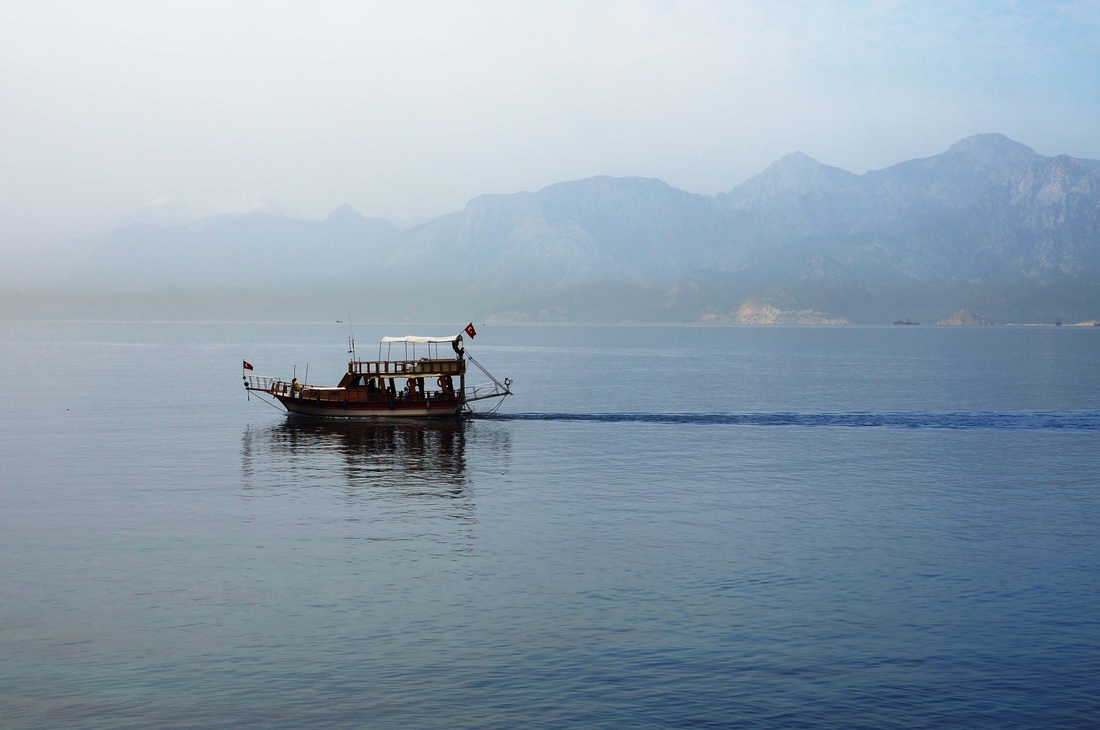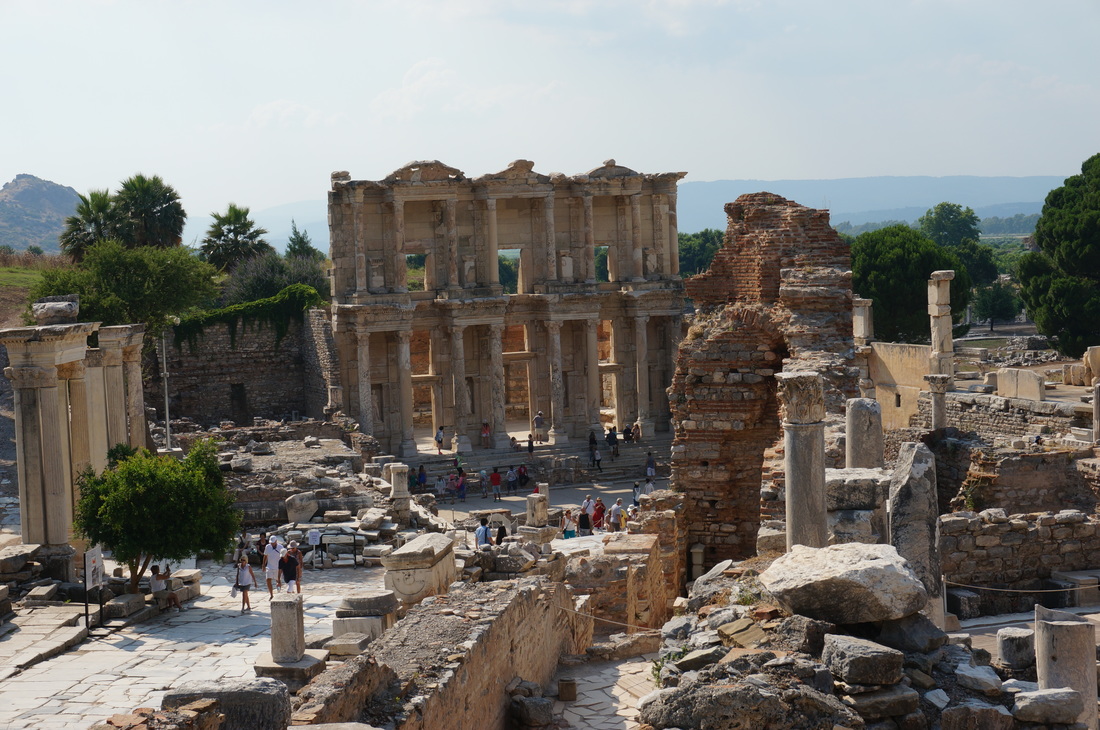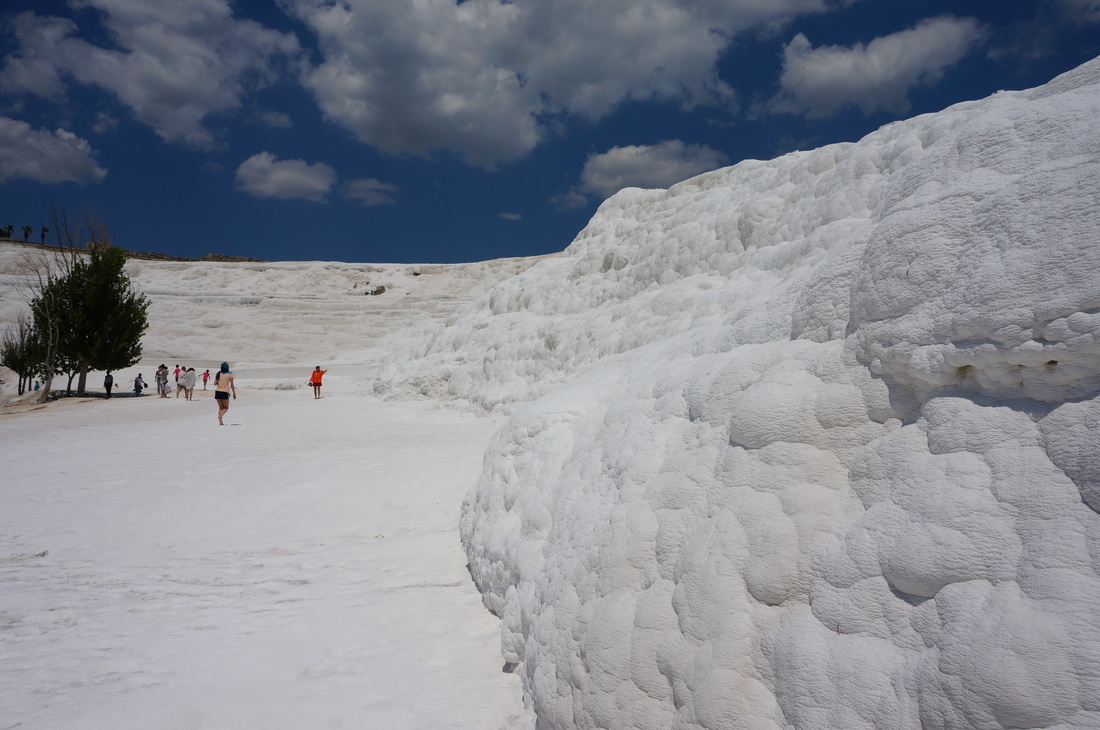Everyone knows Istanbul. It’s one of the largest cities in world. Rich history. Home of the Byzantine, Roman and Ottoman empires. And, as some intuitive souls may like to point out, it’s the place “where east meets west,” culturally and geographically.
Though we’re all familiar with Istanbul (or have at least heard of it), the same can’t be said for the rest of Turkey. Turkey has some of the most amazing natural sights I’ve ever seen and had never heard of. While travelling through the country, I found myself wondering, is Istanbul overrated while Turkey is underrated? This is by no means a jab at Istanbul, merely a testament to the country’s other offerings.
In the way New York City isn’t an accurate representation of the United States, Istanbul doesn’t represent Turkey.
As you move outside the city, the people and landscapes change dramatically. Whereas in Istanbul, you may get shoulder-checked on the street without apology, in Izmir, the bus driver may offer lost tourists a free ride late at night. But then in the tourist town Göreme, you might get laughed at for speaking Turkish as a foreigner.
Turkey is a diverse place, and fortunately, the country has a great transportation system to make it accessible. You can choose between trains, buses and discount flights for nearly all popular destinations. I didn’t get to travel as much as I would have liked to this year, but I hope I can provide a glimpse of some places to see in Turkey besides Istanbul.
Antalya
Though we’re all familiar with Istanbul (or have at least heard of it), the same can’t be said for the rest of Turkey. Turkey has some of the most amazing natural sights I’ve ever seen and had never heard of. While travelling through the country, I found myself wondering, is Istanbul overrated while Turkey is underrated? This is by no means a jab at Istanbul, merely a testament to the country’s other offerings.
In the way New York City isn’t an accurate representation of the United States, Istanbul doesn’t represent Turkey.
As you move outside the city, the people and landscapes change dramatically. Whereas in Istanbul, you may get shoulder-checked on the street without apology, in Izmir, the bus driver may offer lost tourists a free ride late at night. But then in the tourist town Göreme, you might get laughed at for speaking Turkish as a foreigner.
Turkey is a diverse place, and fortunately, the country has a great transportation system to make it accessible. You can choose between trains, buses and discount flights for nearly all popular destinations. I didn’t get to travel as much as I would have liked to this year, but I hope I can provide a glimpse of some places to see in Turkey besides Istanbul.
Antalya
Mid-February to the end of April was a long time. We had no days off and several work-filled weekends before we could enjoy some time to ourselves. Clay worked every Saturday in March with a few in April, and there were a couple occasions where I was off Sunday and he Saturday. I sound whiny — I am — but when the majority of your time is spent with humans whose hands you have to sniff to make sure they washed them after eating honey with breakfast, you really need some time off.
So when we finally got a long weekend, we hightailed it out of the city, where there would be some peace (and a smaller chance of running into our students in public). Our destination of choice was Antalya, Turkey.
Antalya is small, gorgeous city on the Mediterranean Coast that’s easily accessible from Istanbul via a cheap one-hour flight. (Sidenote: Turkish Airlines is amazing, and you should take it if you ever get the opportunity. Check-in is the easiest thing ever, and it provides a sandwich-salad-dessert-drink mealbox for even hour-long flights.)
Antalya is perfect for the strolls through Kaleiçi, the old town and historic city center, lovely panoramic views, and dips in the clear turquoise sea. The water is beautiful with inviting rocks to climb and sit on, and then cry because it’s so pretty it hurts. For me there’s just nothing better than sitting out on the water with a view of mountains in the distance.
Though I would’ve been perfectly content spending every day in the city of Antalya, one day out of our trip we took an $8 bus to Olympos, about an hour-and-a-half away. Olympos is an ancient Lycian city with well-preserved ruins. You can really see the layout of the city and imagine how it appeared in its heyday. After we trekked in, through and around the ruins, we were rewarded (like we hadn’t already been) entrance to an incredible isolated beach with crystal water, rocks tourists had climbed with the intention of jumping off but got scared and lingered at the top for way too long, and locals selling midye dolma (stuffed mussels) and gözleme (Turkish pancakes).
Ephesus
So when we finally got a long weekend, we hightailed it out of the city, where there would be some peace (and a smaller chance of running into our students in public). Our destination of choice was Antalya, Turkey.
Antalya is small, gorgeous city on the Mediterranean Coast that’s easily accessible from Istanbul via a cheap one-hour flight. (Sidenote: Turkish Airlines is amazing, and you should take it if you ever get the opportunity. Check-in is the easiest thing ever, and it provides a sandwich-salad-dessert-drink mealbox for even hour-long flights.)
Antalya is perfect for the strolls through Kaleiçi, the old town and historic city center, lovely panoramic views, and dips in the clear turquoise sea. The water is beautiful with inviting rocks to climb and sit on, and then cry because it’s so pretty it hurts. For me there’s just nothing better than sitting out on the water with a view of mountains in the distance.
Though I would’ve been perfectly content spending every day in the city of Antalya, one day out of our trip we took an $8 bus to Olympos, about an hour-and-a-half away. Olympos is an ancient Lycian city with well-preserved ruins. You can really see the layout of the city and imagine how it appeared in its heyday. After we trekked in, through and around the ruins, we were rewarded (like we hadn’t already been) entrance to an incredible isolated beach with crystal water, rocks tourists had climbed with the intention of jumping off but got scared and lingered at the top for way too long, and locals selling midye dolma (stuffed mussels) and gözleme (Turkish pancakes).
Ephesus
The last day of school finally rolled around in mid-June, and it was the weirdest feeling. I spent every day of the past year with these 18 children, and all of a sudden I knew I would never see them again. It was sad, joyous, relieving, depressing, reflective, and again — weird. I wondered what they’d remember from me and wished I’d had time to teach them more. Like when I told one of my sweet girls goodbye (forever!) and told her to give me a big hug, but instead she kissed me on the mouth. I probably should have reviewed that vocabulary.
The teachers were sticking around for two weeks of seminars, cleaning and desk warming in the quiet company of no one who could tell their age on their fingers. It was going to be a long two weeks of itching for summer, but it was doable. However, late in the afternoon on the second day of “working,” my head teacher alerted me that it was my last day. Oh! OK! Last minute as always, but there was no way I’d be upset about this one.
I went home, got celebratory beers with Clay, and by the next day we had planned a tour of all the sights in Turkey we knew we had to see but didn’t know if we’d be able to.
The first stop of our trip: Ephesus.
Ephesus is an ancient city near the western coast that was founded in the 10th century BC and is currently the home to impressive, well-preserved ruins. It’s housed several peoples and empires over the centuries and is an important place in Christian history. Paul the Apostle lived in Ephesus for a few years developing the church there, and he wrote the letter to the Ephesians while imprisoned in Rome. The gospel of John was supposedly written in Ephesus, as well as what’s believed to be the last home that the Virgin Mary lived in. Clearly, this place holds many stories.
The story I most cared about was retracing my grandmother’s footsteps more than 20 years ago. She did a tour of locations in Turkey and Greece, and Ephesus was her favorite stop.
We left Istanbul in the morning and took a one-hour flight to Izmir. Our airline (Atlas Jet) provided a free shuttle to Selçuk, where we were staying. After checking into our hotel, we made the 3-kilometer walk to Ephesus — a world so different we kept reminding ourselves we had woken up in Taksim the same day.
I was not prepared for the scope of the ancient city. It’s massive and intricate. We sat in the theater for a good half hour imagining all of the sights the arena had witnessed — philosophers, preachers, gladiator battles, plays, what else?
The whole of Ephesus is so extensive it really makes it possible to imagine daily life in its prime. It doesn’t feel like a pile of cement; it truly is the remains of a town. If you ever go to Ephesus, be forewarned: It will spoil you for ruins. For example, the next time I saw ruins — in Santorini — I couldn’t help but think it was just a bunch of rocks. It was nothing like the city I’d seen in Turkey.
Our second day in Selçuk, we took a bus to a “charming” wine town we’d heard about called Şirince. Essentially, it’s a small Turkish town that’s a peculiar combination of truly local and insanely touristy — a weird mix. Şirince is known for its fruit wines, but with the exception of mulberry, we found all the flavors to be medicine-flavored and overly sweet. I suppose it’s a nice place to stroll and sample wines for a bit, but I won’t be adding it to my next itinerary. I’ll also stick to my cabernet sauvignon.
Pamukkale
The teachers were sticking around for two weeks of seminars, cleaning and desk warming in the quiet company of no one who could tell their age on their fingers. It was going to be a long two weeks of itching for summer, but it was doable. However, late in the afternoon on the second day of “working,” my head teacher alerted me that it was my last day. Oh! OK! Last minute as always, but there was no way I’d be upset about this one.
I went home, got celebratory beers with Clay, and by the next day we had planned a tour of all the sights in Turkey we knew we had to see but didn’t know if we’d be able to.
The first stop of our trip: Ephesus.
Ephesus is an ancient city near the western coast that was founded in the 10th century BC and is currently the home to impressive, well-preserved ruins. It’s housed several peoples and empires over the centuries and is an important place in Christian history. Paul the Apostle lived in Ephesus for a few years developing the church there, and he wrote the letter to the Ephesians while imprisoned in Rome. The gospel of John was supposedly written in Ephesus, as well as what’s believed to be the last home that the Virgin Mary lived in. Clearly, this place holds many stories.
The story I most cared about was retracing my grandmother’s footsteps more than 20 years ago. She did a tour of locations in Turkey and Greece, and Ephesus was her favorite stop.
We left Istanbul in the morning and took a one-hour flight to Izmir. Our airline (Atlas Jet) provided a free shuttle to Selçuk, where we were staying. After checking into our hotel, we made the 3-kilometer walk to Ephesus — a world so different we kept reminding ourselves we had woken up in Taksim the same day.
I was not prepared for the scope of the ancient city. It’s massive and intricate. We sat in the theater for a good half hour imagining all of the sights the arena had witnessed — philosophers, preachers, gladiator battles, plays, what else?
The whole of Ephesus is so extensive it really makes it possible to imagine daily life in its prime. It doesn’t feel like a pile of cement; it truly is the remains of a town. If you ever go to Ephesus, be forewarned: It will spoil you for ruins. For example, the next time I saw ruins — in Santorini — I couldn’t help but think it was just a bunch of rocks. It was nothing like the city I’d seen in Turkey.
Our second day in Selçuk, we took a bus to a “charming” wine town we’d heard about called Şirince. Essentially, it’s a small Turkish town that’s a peculiar combination of truly local and insanely touristy — a weird mix. Şirince is known for its fruit wines, but with the exception of mulberry, we found all the flavors to be medicine-flavored and overly sweet. I suppose it’s a nice place to stroll and sample wines for a bit, but I won’t be adding it to my next itinerary. I’ll also stick to my cabernet sauvignon.
Pamukkale
Pamukkale was the next stop of our Turkish tour, and I really can’t describe it any way other than “it was awesome” with a big goofy grin. We got there by taking a three-hour train from Selçuk to Denizli, then a half-hour bus from Denizli to Pamukkale. Easy.
Pamukkale, which means “Cotton Castles” in Turkish, seriously looks like an alien landscape. It’s so white it hurt my eyes through my sunglasses, and it resembles piles of billowy snow. As soon as you reach the peak where the hot springs are, visitors are required to remove their shoes for the rest of the walk. The ground, as it’s covered in flowing water, looks like it’d have a banana peel effect on someone as graceful as me, but instead, it has a grainy, grippy texture that’s really satisfying to walk across.
There are hundreds of thermal pools — some empty, some not — resting in travertine terraces. The pools are about knee deep, and perfect for just sitting and leaning back against the edge of the terrace. Soft clay sits at the bottom of the pool, and many of the locals use it as a natural sunscreen.
I’ve read the Pamukkale Wikipedia page a dozen times, and I still don’t exactly understand what it is. However, I can say that it’s worthy of a spot on the bucket list. I mean, it’s just so cool.
I’ll talk about my trips to Cappadocia and the Greek Islands in my next post.
Pamukkale, which means “Cotton Castles” in Turkish, seriously looks like an alien landscape. It’s so white it hurt my eyes through my sunglasses, and it resembles piles of billowy snow. As soon as you reach the peak where the hot springs are, visitors are required to remove their shoes for the rest of the walk. The ground, as it’s covered in flowing water, looks like it’d have a banana peel effect on someone as graceful as me, but instead, it has a grainy, grippy texture that’s really satisfying to walk across.
There are hundreds of thermal pools — some empty, some not — resting in travertine terraces. The pools are about knee deep, and perfect for just sitting and leaning back against the edge of the terrace. Soft clay sits at the bottom of the pool, and many of the locals use it as a natural sunscreen.
I’ve read the Pamukkale Wikipedia page a dozen times, and I still don’t exactly understand what it is. However, I can say that it’s worthy of a spot on the bucket list. I mean, it’s just so cool.
I’ll talk about my trips to Cappadocia and the Greek Islands in my next post.




 RSS Feed
RSS Feed
